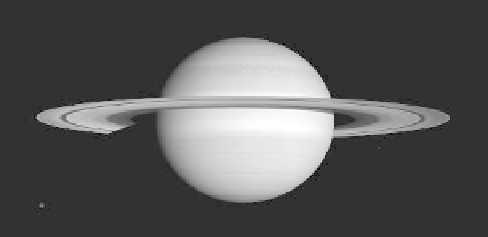Geology Reference
In-Depth Information
The Cassini orbiter carries an imaging system, spec-
trometers in the visible, IR, and UV ranges, and a radar
imaging system to map Titan
'
s surface through the dense
clouds. The payload also includes a magnetometer sys-
tem, plasma spectrometer, cosmic dust analyzer, and an
ion/neutral-species mass spectrometer. Following the
release of the Huygens probe, Cassini was placed in
orbit around Saturn in July 2004, with subsequent paths
designed to make close
flybys of the various satellites,
similar to the sequences used by Galileo in orbit around
Jupiter, and to make repeated observations of Saturn and
the rings. Among the many exciting
findings was the
discovery in 2005 that Enceladus is a geologically active
object with erupting plumes of volatiles from its south
polar region. Particularly important for planetary geology
are the observations of Titan obtained by Cassini
Figure 9.1. This view of Saturn is a mosaic of 30 images taken by the
Cassini orbiter in 2008, showing its prominent rings and the relatively
bland clouds (NASA PIA11141).
features that last from a few days to several years, appa-
rently indicating the presence of storm systems. Unlike
storms on Earth, which are driven primarily by heating
from the Sun, saturnian storms are probably generated
from heat derived from the interior of the planet. One of
the most distinctive features is the Great White Spot,
which is short-lived and appears and disappears about
every Saturn year (30 Earth years). It is considered anal-
ogous in some ways to Jupiter
'
s Great Red Spot; it typi-
cally begins as a small bright feature in the northern
hemisphere that expands laterally into an oval feature as
wide as several thousand kilometers.
s radar
system, which is capable of imaging the surface through
the dense clouds. As this mission continues, swaths of
radar data are slowly building a map of the surface of this
intriguing moon. The orbiter is scheduled to continue
operations until 2017, and, if all goes well, the result
will be 155 orbits of Saturn, 53
flybys of Titan, and 11
flybys of Enceladus, thus enabling long-term study of the
active plumes.
'
9.3 Saturn
9.4 Satellites
Saturn
'
is density is about 0.7 g/cm
3
, which is the lowest of
all the planets. Like that of Jupiter, Saturn
'
s atmosphere
consists of about 80% hydrogen, 18% helium, and
amounts of oxygen, iron, neon, nitrogen, and sulfur total-
ling less than 2%. The interiors of Saturn and Jupiter are
also similar, with both probably having mantles and rocky
cores. Saturn spins on its axis extremely rapidly, taking
only 10 hours to complete one rotation. The high spin rate,
coupled with the interior con
guration of core and mantle,
probably accounts for its large magnetic field, which is
only slightly weaker than that of Earth but is much weaker
than Jupiter
'
s enormous
field. The rapid spin also causes a
flattening of the poles and an equatorial bulge, leading to
Saturn
The Saturn system (
Fig. 9.2
) has about the same number
of known moons as Jupiter, with ~62 satellites that range
in size from less than 10 km across to the Mercury-size
object Titan, which has its own atmosphere of nitrogen
that exerts a surface pressure of 1.45 bar (greater than that
on Earth). All of the satellites have densities suggesting
that they are ice-rich objects with different amounts of
rocky material in their interiors. The nine largest moons
were discovered telescopically, some as early as 1655.
Most of their names are taken from Greek mythology, in
which Dione, Rhea, Tethys, Mimas, Enceladus, Titan, and
Phoebe were giants, while Hyperion and Iapetus were
brothers of Saturn.
Saturn
'
s moons display a wide variety of orbital
motions. Twenty-four are regular satellites, meaning that
they are traveling in the same direction as Saturn
'
s spin.
Most of the remaining moons are irregular satellites,
thought to be captured objects, which travel in a wide
variety of inclined retrograde orbits.
s oblate spheroid shape.
Although the atmosphere and cloud patterns on Saturn
are not as spectacular as those on Jupiter, they are none-
theless interesting. Like that of Jupiter, its atmosphere is
zoned, but the patterns are fainter and somewhat bland
(
Fig. 9.1
). Saturn
'
s winds have been clocked at some
500 m/s. Shear and up-welling of the atmosphere lead to
some distinctive cloud patterns, including oval-shaped
'





